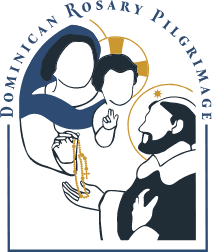The Sights and Sounds of Christmas
Dominican Friars

Christmas appeals, above all, to the senses. It reveals and manifests. You can hear and see it. It is luminous.
We often think of the Word taking on flesh in connection with Christmas. This is not wrong, but in reality, that mystery is celebrated nine months earlier, almost always hidden away in that long and purifying season of Lent. When Mary conceived by the Holy Spirit, the Son took on human flesh in the most hidden and secret way. Only Mary was aware of the mystery of the Incarnation at the moment when the Word assumed our human nature.
Christmas, on the other hand, is more about the unveiling of the Incarnate Lord. For nine months, the Blessed Mother was the true tabernacle as she carried our Lord in her womb. On Christmas day, Christ showed the world his human face. His mother became a living monstrance, the earthen floor an altar. Those present—her husband, Joseph, the poor shepherds, and the wise men—adored the babe-made-visible through whom the mystery of the Incarnation was now made manifest.
The above painting by Caravaggio illustrates this progressive manifestation: the Lord shows himself, he in turn is shown by his mother, and both are shown by Joseph. The figures are not in their traditional crèche positions. Our Lord is not in the feeding trough or on the floor. He rests awake, encircled by the arms of his mother. He gazes upward at her face, as if himself caught up in the wonder of seeing his mother for the first time with human eyes. Their mouths nearly touch, and they seem to talk without using words. The sense of touch also dominates the image. Mary’s large hands envelope the little boy. Jesus’ hands, in turn, rest over the heart of his mother. She simultaneously holds and displays the Incarnate One, although her attention is only on her Son.
Next comes Joseph. He wears red like his wife. His eyes and hands receive great accent as well. He looks at Mary and Jesus. Upon whom he gazes in particular is unclear, so close are the faces of Mary and Jesus to one another. His right hand reaches out as if to touch his beloved. His left seems to protect his family. But together, these hands appear to introduce the poor shepherds behind him to his newborn Son. Look! he seems to say. He directs their gaze to the mystery whose face is now visible. They will, in turn, glorify and praise God for all they hear and see (Lk 2:20).
Our Lord has shown his face. His cooing voice can be heard. He can be touched, kissed, and embraced. His warmth can warm the breasts of those who dare to hold him. As this Christmas season progresses, so too will the manifestation of the Lord’s presence among us. The feast of the Epiphany will recall how the wise men followed a star and eventually came to Bethlehem. Matthew will tell us how they “saw the child with Mary his mother” and “prostrated themselves and did him homage” (Mt 2:11). At his circumcision, Simeon will sing, “my eyes have seen your salvation,” and call our Lord the “light” that reveals. The prophetess Anna, after waiting a lifetime, will see him, give “thanks to God and” speak “about the child to all who were awaiting the redemption of Jerusalem” (Lk 2:38). We will eventually hear the voice of the Baptist as he points to Jesus: “Behold, the Lamb of God” (Jn 1:36). Christmas will finally reach its end in the manifestation at Jesus’s baptism by John. We will see “the Spirit of God descending like a dove” and we will hear “a voice . . . from the heavens, saying, ‘This is my beloved Son’” (Mt 3:16-17).
All of this is summarized by another John.
What was from the beginning,
1 John 1:1-2a
what we have heard,
what we have seen with our eyes,
what we looked upon
and touched with our hands
concerns the Word of life—
for the life was made visible;
we have seen it and testify to it.
This article was originally published in the dominicanajournal.org and was written by Fr. Bernard Knapke, O.P..
Painting is “Adoration of the Shepherds” (1609) by Caravaggio.
